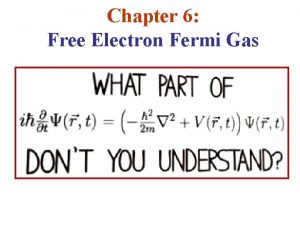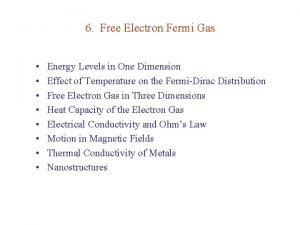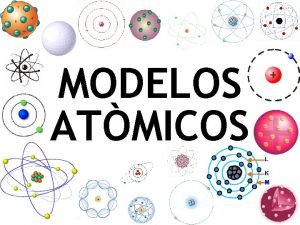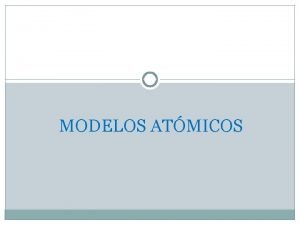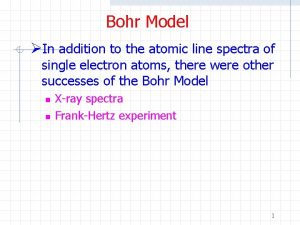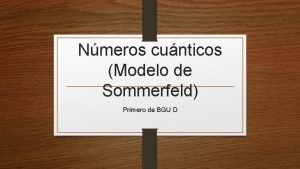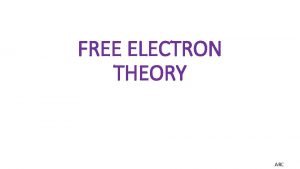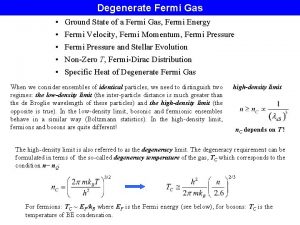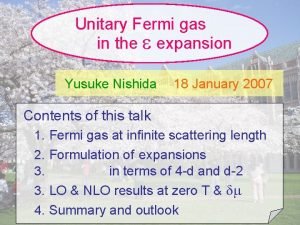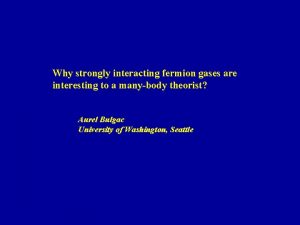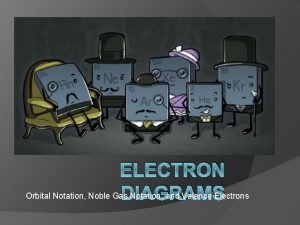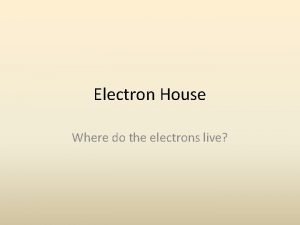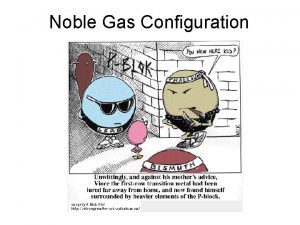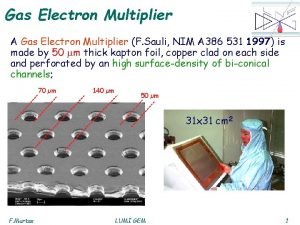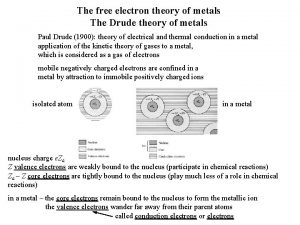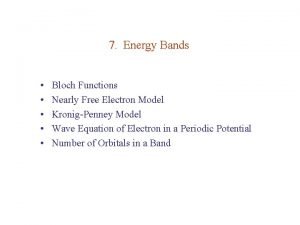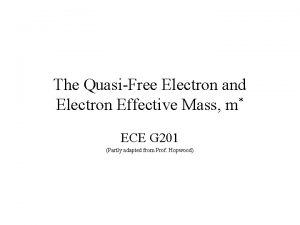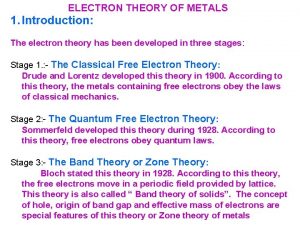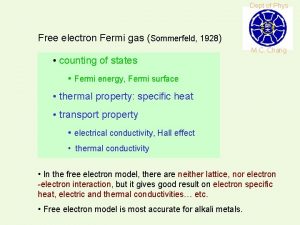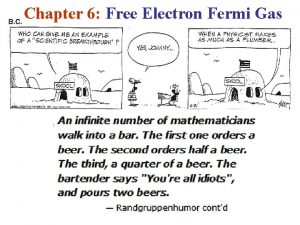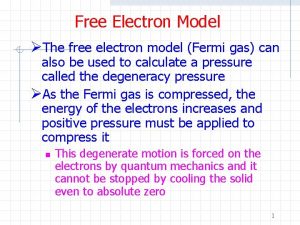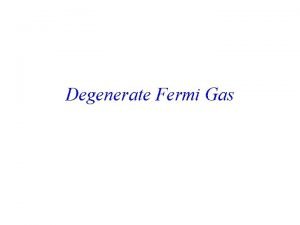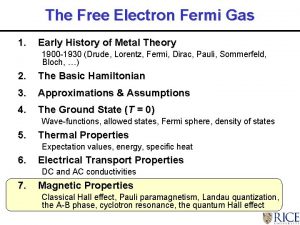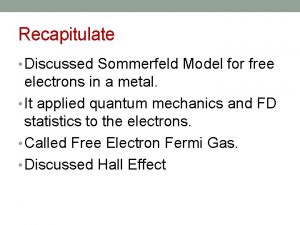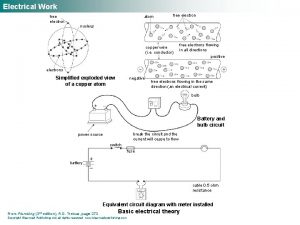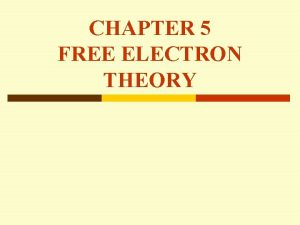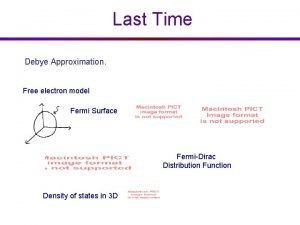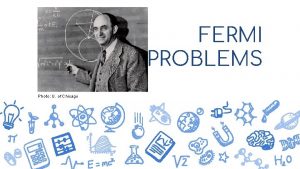Dept of Phys Free electron Fermi gas Sommerfeld






















- Slides: 22

Dept of Phys Free electron Fermi gas (Sommerfeld, 1928) • counting of states 1926: Schrodinger eq. , FD statistics M. C. Chang • Fermi energy, Fermi surface • thermal property: specific heat • transport property • electrical conductivity, Hall effect • thermal conductivity • In the free electron model, there is neither lattice, nor electron-electron interaction, but it gives good result on electron specific heat, electric and thermal conductivities… etc. • Free electron model is most accurate for alkali metals.

… L. Hoddeson et al, Out of the crystal maze, p. 104

Quantization of k in a 1 -dim box • Plane wave solution “Box” BC k = π/L, 2π/L, 3π/L… Periodic BC (PBC) k = ± 2π/L, ± 4π/L, ± 6π/L…

Free electron in a 3 -dim box z Lz Lx x Ly y Advantage: allows travelling waves

Quantization of k in a 3 -dim box BC periodic BC • Each point can have 2 electrons (because of spin). After filling in N electrons, the result is a spherical sea of electrons called the Fermi sphere. Its radius is called the Fermi wave vector, and the energy of the outermost electron is called the Fermi energy. • Different BCs give the same Fermi wave vector and the same energy box BC periodic BC

Connection between electron density and Fermi energy F • For K, the electron density n=1. 4× 1028 m-3, therefore • εF is of the order of the atomic energy levels. • k. F is of the order of a-1.

Fermi temperature and Fermi velocity • The Fermi temperature is of the order of 104 K

important Density of states D(ε) (DOS, 態密度) • D(ε)dε is the number of states within the energy surfaces of ε and ε+dε • For a 3 D Fermi sphere,

• Free electron DOS (per volume) in 1 D, 2 D, and 3 D • Multiple bound states in 2 D z ⊥

• counting of states • Fermi energy, Fermi surface • thermal property: specific heat • transport property • electrical conductivity, Hall effect • thermal conductivity

important • Thermal distribution of electrons (fermions) • Combine DOS D(E) and thermal dist f(E, T) D( ) Hotel rooms tourists money D( )

Electronic specific heat, heuristic argument (see Kittel p. 142 for details) • Only the electrons near the Fermi surface are excited by thermal energy k. T. The number of excited electrons are roughly of the order of N’ = N(k. T /EF) • The energy absorbed by the electrons is U(T)-U(0) ~ NA (k. T)2/EF • specific heat Ce ~ d. U/d. T = 2 R k. T/EF = 2 R T/TF a factor of T/TF smaller than classical result • T/TF ~ 0. 01 Therefore usually electron specific is much smaller than phonon specific heat • In general C = Ce + C p = γT + AT 3 Ce is important only at very low T.


• counting of states • Fermi energy, Fermi surface • thermal property: specific heat • transport property • electrical conductivity, Hall effect • thermal conductivity

Electrical transport Classical view Relaxation time • Electric resistance comes from electron scattering with defects and phonons. • If these two types of scatterings are not related, then scattering rate: • Current density (n is electron density) Electric conductivity

Semi-classical view • The center of the Fermi sphere is shifted by Δk = -e. Eτ. • One can show that when Δk<<k. F, V沒重疊/V重疊~ 3/2(Δk/k. F). • Therefore, the number of electrons being perturbed away from equilibrium is only about (Δk/k. F)Ne, or (vd/v. F)Ne • Semiclassical vs classical: The results are the same. But the microscopic pictures are very different. • v. F vs vd (differ by 109 !) • (vd /v. F) Ne vs Ne

Calculating the scattering time τ from measured resistivity ρ • At room temp . The electron density →τ= m/ρne 2 = 2. 5× 10 -14 s • Fermi velocity of copper ∴ mean free path = v. Fτ= 40 nm. • For a very pure Cu crystal at 4 K, the resistivity reduces by a factor of 105, which means increases by the same amount ( = 0. 4 cm!). This cannot be explained using classical physics. • For a crystal without any defect, the only resistance comes from phonon. Therefore, at very low T, the electron mean free path theoretically can be infinite. K dirty clean Residual resistance at T=0

Hall effect (1879) Classical view: (consider only 2 -dim motion) |ρH| B

(ρH) 藉著測量霍爾係數可以推算自由電子濃度。 Positive Hall coefficient? Can’t be explained by free electron theory. Band theory (next chap) is required.

optional Quantum Hall effect (von Klitzing, 1979) quantum classical 1985 • Rxy deviates from (h/e 2)/C 1 by less than 3 ppm on the very first report. • This result is independent of the shape/size of sample. • h/e 2=25812. 807572(95) Ω offers one of the most accurate way to determine the Planck constant.

optional An accurate and stable resistance standard (1990)

Thermal conduction in metal • Both electron and phonon carry thermal energy (Electrons are dominant in metals). • Similar to electric conduction, only the electrons near the Fermi energy can contribute thermal current. Heat capacity per unit volume • Wiedemann-Franz law (1853): for a metal, thermal conductivity is closely related to electric conductivity. Lorentz number: K/σT=2. 45× 10 -8 watt-ohm/deg 2
 Fermi velocity
Fermi velocity Free fermi gas
Free fermi gas Modelo atomico modelo actual
Modelo atomico modelo actual Sommerfeld modelo atomico
Sommerfeld modelo atomico Discus technique for beginners
Discus technique for beginners Franck hertz
Franck hertz Spin positivo y negativo
Spin positivo y negativo Drawbacks of classical free electron theory
Drawbacks of classical free electron theory Degenerate electron gas
Degenerate electron gas Fermi gas
Fermi gas Unitary fermi gas
Unitary fermi gas Heisenberg
Heisenberg What is orbital notation
What is orbital notation Electron configuration vs noble gas configuration
Electron configuration vs noble gas configuration Electron house
Electron house Why are they called noble gases
Why are they called noble gases Gas electron multiplier
Gas electron multiplier Drude theory of metals
Drude theory of metals Nearly free electron model
Nearly free electron model Fexedx
Fexedx Drawbacks of free electron theory
Drawbacks of free electron theory Uiuc physics 102
Uiuc physics 102 Phys 101 uiuc
Phys 101 uiuc
